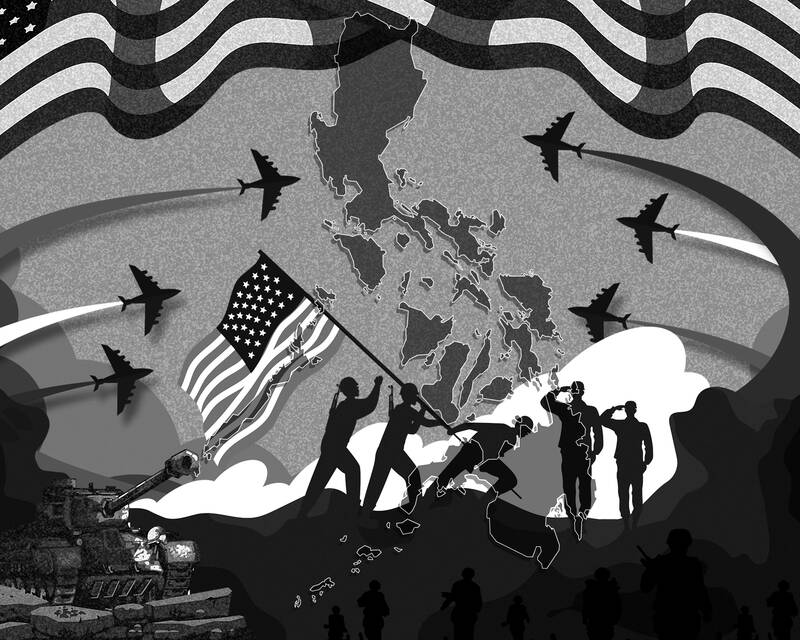Once-secret ammunition bunkers and barracks lie abandoned, empty and overrun by weeds — vestiges of US firepower in what used to be its largest overseas naval base at Subic Bay in the northern Philippines.
However, that might change in the near future.
The US has been taking steps to rebuild its military might in the Philippines more than 30 years after the closure of its large bases in the country, and is reinforcing an arc of military alliances in Asia in a starkly different post-Cold War era in which the perceived new regional threat is an increasingly belligerent China.

Illustration: Louise Ting
On Tuesday last week, the longtime allies announced that rotating batches of US forces would be granted access to four more Philippine military camps aside from the five local bases at which US-funded construction has sped up on barracks, warehouses and other buildings to accommodate a yet unspecified, but expectedly considerable number of visiting troops under a 2014 defense pact.
Manila-based political scientist Andrea Chloe Wong (黃美慧) said the location of the Philippine camps would give the US military the presence it needs to be a “strong deterrent against Chinese aggression” against Taiwan, as well as in the South China Sea, where Taiwan, China, the Philippines and three other nations have had increasingly tense territorial rifts.
Near the former US Navy base in Subic City, now a bustling commercial port and tourism destination northwest of Manila, news of the Philippine government’s decision to allow an expanded US military presence rekindled memories of an era when thousands of US sailors pumped money, life and hope into the neighboring city of Olongapo.
“Olongapo was like Las Vegas then,” local businessman A.J. Saliba said in an interview in his foreign currency exchange and music shop along what used to be Olongapo’s garish red-light strip.
“Noisy as early as noon with neon lights turned on and the Americans roaming around. Women were everywhere. Jeepney drivers, tricycles, restaurants, bars, hotels — everybody was making money — so if they will return, my God, you know, that’ll be the best news,” he said.
During a visit to Manila this month, US Secretary of Defense Lloyd Austin said that Washington was not trying to re-establish permanent bases, but that the approval to broaden its military presence under the bilateral Enhanced Defense Cooperation Agreement was “a big deal.”
Visiting US military personnel could engage the Philippine military in larger joint combat readiness exercises, provide help in responding rapidly to disasters and press efforts to help modernize Manila’s armed forces, Austin and Philippine Secretary of National Defense Carlito Galvez Jr said.
“This is part of our effort to modernize our alliance, and these efforts are especially important as the People’s Republic of China continues to advance its illegitimate claims in the West Philippine Sea,” Austin told a news conference in Manila, using the Philippine government’s name for the parts of the South China Sea that it claims as its territorial waters.
Chinese Ministry of Foreign Affairs spokeswoman Mao Ning (毛寧) said that the US military’s foothold in the region was escalating tensions and risking peace and stability.
“Regional countries need to remain vigilant and avoid being coerced or used by the US,” Mao told reporters at a briefing in Beijing last week.
Austin and Galvez did not reveal the four new locations where the US would be granted access and allowed to preposition weapons and other equipment.
Galvez said officials stationed at the bases where the US soldiers would stay had to be consulted.
In November last year, then-Philippine Armed Forces chief of staff Lieutenant General Bartolome Bacarro disclosed that the sites included the strategic Subic Bay.
However two senior Philippine officials said that Subic City, where the Philippine Navy operates a camp, was not on a list of sites where Washington has sought access for its forces.
However, they added that the list could change, as talks were continuing.
The two officials spoke on condition of anonymity because they were not authorized to discuss the issue publicly.
Subic Bay Metropolitan Authority Administrator Rolen Paulino said he had not been notified by the Philippine government that the former US naval base had been designated as a potential site for visiting US forces.
However, a renewed US military presence at the site would generate more jobs and raise additional port revenues at a crucial time when many Filipinos and businesses are still struggling to recover from two years of COVID-19 restrictions and an economic recession wrought by outbreaks of the disease, Paulino said.
“I see them as tourists,” he said of the US forces whose presence could boost economic recovery.
About the size of Singapore, the former US Navy base, a ship repair yard and huge warehouses had been used to support the US war effort in Vietnam in the 1960s and 1970s. It was shut down in 1992 and transformed into a commercial port and recreational complex after the Philippine Senate rejected an extension of the US’ lease.
A year earlier, the US Air Force withdrew from the nearby Clark Air Base after Mount Pinatubo roared back to life in the second-largest volcanic eruption of the 20th century and belched ash on the facilities.
The US flag was lowered for the final time and the last batch of US sailors left Subic in November 1992, ending nearly a century of US military presence in the nation, which began in 1898 when the US seized the Philippines in a new colonial era after Spain held the archipelago as a colony for more than three centuries. Washington granted it independence on July 4, 1946, but maintained military bases and facilities, including Subic.
China’s seizure in the mid-1990s of the Mischief Reef (Meiji Reef, 美濟礁) in the Spratly Islands (Nansha Islands, 南沙群島), a coral outcrop that is also claimed by Taiwan near the exclusive economic zone of the Philippines, “provided the first hint that the allies may have been too quick to downgrade their relationship,” said Greg Poling, director of the Asia Maritime Transparency Initiative at the Washington-based Center for Strategic and International Studies.
The Philippine constitution prohibits permanent basing of foreign troops in the country and their involvement in local combat, but allows temporary visits by foreign troops under security pacts such as the 2014 Enhanced Defense Cooperation Agreement and a 1998 Visiting Forces Agreement.
The 1998 agreement allowed a large number of US forces to be deployed in the southern Philippines to help provide combat training and intelligence to Philippine forces battling the Abu Sayyaf militant group, which was blamed for deadly bombings and mass kidnappings for ransom, including three Americans — one of whom was beheaded and another shot and killed in a Philippine Army rescue. The third survived.
However, there is still domestic opposition to a US presence in the Philippines, which left-wing groups have criticized as neo-colonialism, reinforced by the 2014 killing of a transgender Filipina by a US marine, Wong said.
Manuel Mamba, governor of northern Cagayan province, where Bacarro said the US has reportedly sought access for its forces in two local military encampments, vowed to oppose such a US military presence.
Cagayan, on the northern tip of Luzon Island, lies across a narrow stretch of sea from Taiwan, the Taiwan Strait and southern China.
“It’ll be very dangerous for us. If they stay here, whoever is their enemy will become our enemy,” Mamba said, adding that the Philippines could be targeted by nuclear weapons if the conflict over Taiwan boils over.
“You cannot really remove any presumption by anyone that the Philippines has a nuclear capability through the Americans, who will be here,” Mamba said.

US President Donald Trump has gotten off to a head-spinning start in his foreign policy. He has pressured Denmark to cede Greenland to the United States, threatened to take over the Panama Canal, urged Canada to become the 51st US state, unilaterally renamed the Gulf of Mexico to “the Gulf of America” and announced plans for the United States to annex and administer Gaza. He has imposed and then suspended 25 percent tariffs on Canada and Mexico for their roles in the flow of fentanyl into the United States, while at the same time increasing tariffs on China by 10
As an American living in Taiwan, I have to confess how impressed I have been over the years by the Chinese Communist Party’s wholehearted embrace of high-speed rail and electric vehicles, and this at a time when my own democratic country has chosen a leader openly committed to doing everything in his power to put obstacles in the way of sustainable energy across the board — and democracy to boot. It really does make me wonder: “Are those of us right who hold that democracy is the right way to go?” Has Taiwan made the wrong choice? Many in China obviously
US President Donald Trump last week announced plans to impose reciprocal tariffs on eight countries. As Taiwan, a key hub for semiconductor manufacturing, is among them, the policy would significantly affect the country. In response, Minister of Economic Affairs J.W. Kuo (郭智輝) dispatched two officials to the US for negotiations, and Taiwan Semiconductor Manufacturing Co’s (TSMC) board of directors convened its first-ever meeting in the US. Those developments highlight how the US’ unstable trade policies are posing a growing threat to Taiwan. Can the US truly gain an advantage in chip manufacturing by reversing trade liberalization? Is it realistic to
Last week, 24 Republican representatives in the US Congress proposed a resolution calling for US President Donald Trump’s administration to abandon the US’ “one China” policy, calling it outdated, counterproductive and not reflective of reality, and to restore official diplomatic relations with Taiwan, enter bilateral free-trade agreement negotiations and support its entry into international organizations. That is an exciting and inspiring development. To help the US government and other nations further understand that Taiwan is not a part of China, that those “one China” policies are contrary to the fact that the two countries across the Taiwan Strait are independent and